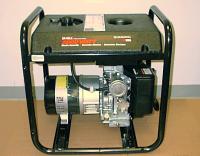Recall: DeVilbiss Air Power Company Portable Generator Alert
| FOR IMMEDIATE RELEASE December 30, 1999 Release # 00-047 |
DAPC Toll Free Line: (800) 888-2468 CPSC Consumer Hotline: (800) 638-2772 CPSC Media Contact: Ken Giles, (301) 504-7052 |
Safe Generator Use for Y2K: CPSC, DeVilbiss Air Power Company Alert Consumers About Gasoline Tanks on Certain Portable Generators
WASHINGTON, D.C. - % joins DeVilbiss Air Power Company (DAPC) of Jackson , Tenn., in alerting consumers about gasoline tanks used on certain models of portable generators. About 295,000 of these generators were sold nationwide from February 1996 until June 1999. CPSC and DAPC are investigating whether the fuel tanks on the generators can crack where the tanks mount on the frame, posing a fire hazard. As a precaution until that evaluation is complete, consumers should not put more than three gallons of gasoline in the fuel tanks at any time.
The only generators affected by this notice have the following brand names: DeVilbiss Air Power Company, EX-CELL, PowerBack, Companion Model 919-32721, and Craftsman Model No. 919-32651. The seven gallon tanks that are affected include only those tanks that bear dates prior to June 1, 1999. The date is on the serial barcode label found on one of the gasoline tank support rails and on the shipping carton label.
Any consumer who has seen leakage from the tank should not use the generator and should contact DAPC at (800) 888-2468, ext. 21 or at www.devap.com to obtain a free warranty replacement tank. Consumers with questions can contact DAPC directly rather than contacting retailers. Consumers also can contact CPSC at (800) 638-2772.
Many people have been buying generators as a precaution in case there are power outages because of Y2K. CPSC believes that Y2K will not result in major power outages. However, if you use a generator, you need to take precautions to prevent carbon monoxide poisoning, gasoline ignition, and electrocution.

- Carbon Monoxide Poisoning: Do not use gasoline generators indoors. Generators produce carbon monoxide, an odorless, colorless gas that can kill people. Each year, carbon monoxide from fuel-burning appliances kills approximately 200 people and sends 10,000 people to hospital emergency rooms. Symptoms of carbon monoxide poisoning are similar to the flu, including nausea, headache, dizziness, and irregular breathing. Exposure to high levels of carbon monoxide can cause death.
CPSC recommends that every home should have a carbon monoxide alarm that meets the requirements of the most recent UL 2034 standard or the International Approval Services 6-96 standard. Generators should be used only outdoors in a well-ventilated, dry area, away from air intakes to the home, and protected from direct exposure to rain and snow.
- Gasoline Ignition: Do not store gasoline indoors. Gasoline fumes can travel across a room and be ignited by a water heater or some other ignition source. Gasoline and other flammable liquids should be stored outside the home in safety containers.
- Electrocution: Portable generators can also present a risk of electrocution if they are not properly connected to the home electrical wiring system. Do not plug the generator power leads into a wall outlet. Have a qualified electrician hook up the standby electrical system, or have the local utility install a linking device if available.